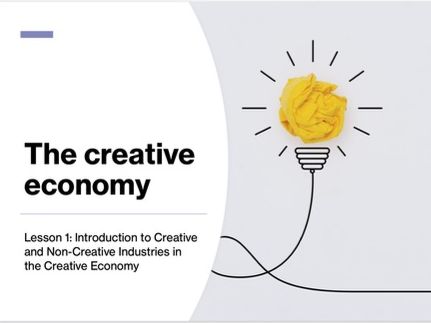

“The Creative Economy”, is a structured, multi-lesson learning program designed to support the T Level Technical Qualification in Media, Broadcast, and Production Core Component. Specifically, it focuses on the Creative Economy, a foundational topic in the qualification that explores how creativity and commerce intersect in the media and cultural industries.
Overview and Purpose
The resource introduces students to the creative economy, defined as the system of industries that revolve around creativity, culture, economics, and technology. It builds a comprehensive understanding of how creative roles (e.g., filmmakers, designers, performers) work in tandem with non-creative roles (e.g., finance, legal, logistics) to bring media products to market.
Key Areas Covered
Creative and Non-Creative Industries
Definitions, examples, and interrelationships.
Exploration of job roles and their responsibilities across business, design, production, and technical functions.
Case Studies and Job Role Mapping
Real-world organisations like Sunset+Vine, Universal Everything, and Mesmer
are used to identify and analyse industry roles and structures.
Types of Organisations
Overview of ten types of entities in the creative sector including corporations, SMEs, freelancers, charities, and public broadcasters.
Creative Supply Chain
Examination of the end-to-end process from ideation to audience delivery.
Real case study examples like film production and the Netflix model.
Production Process
Breaks down the five stages: establishing need, ideation, pre-production, production/post-production, and execution.
Compliance and Distribution
Practical examples such as YouTube’s Content ID system, covering legal and archival issues.
Monetisation Models
Insight into four core methods: commissioned, co-productions, self-generated, and subscription models.
Benefits and challenges of each, linked to sustainability in the sector.
Finance and Funding Sources
Commercial revenue, sponsorship, crowdfunding, incentives, and grants.
Guidance on choosing appropriate models for different types of media products.
Trade Unions and Regulatory Bodies
Roles of key UK unions (e.g., BECTU, NUJ) and regulators (e.g., Ofcom, ASA).
How these entities protect workers and ensure ethical media practices.
Educational Features:
Tasks & Activities: Interactive group tasks, case study analyses, and media production planning assignments.
Assessment Preparation: Summary questions and essay prompts aligned with T Level Core Component outcomes.
Digital Integration: Includes activities for platforms like Kahoot and WordPress for engagement and reflection.
Media Literacy Development: Encourages critical thinking around funding, compliance, and economic sustainability.
Something went wrong, please try again later.
This resource hasn't been reviewed yet
To ensure quality for our reviews, only customers who have purchased this resource can review it
to let us know if it violates our terms and conditions.
Our customer service team will review your report and will be in touch.